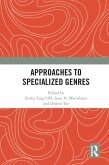- Gebundenes Buch
- Merkliste
- Auf die Merkliste
- Bewerten Bewerten
- Teilen
- Produkt teilen
- Produkterinnerung
- Produkterinnerung
Providing a simple - but not simplistic - introduction to the Systemic Functional Grammar of English, this book serves as a launching pad for the beginning student or a review for the more seasoned linguist.
Andere Kunden interessierten sich auch für
![A Systemic Functional Grammar of English A Systemic Functional Grammar of English]() David BanksA Systemic Functional Grammar of English36,99 €
David BanksA Systemic Functional Grammar of English36,99 €![Introducing M.A.K. Halliday Introducing M.A.K. Halliday]() Bo WangIntroducing M.A.K. Halliday168,99 €
Bo WangIntroducing M.A.K. Halliday168,99 €![The Functional Analysis of English The Functional Analysis of English]() Thomas BloorThe Functional Analysis of English214,99 €
Thomas BloorThe Functional Analysis of English214,99 €![Introducing English Grammar Introducing English Grammar]() Kersti BörjarsIntroducing English Grammar168,99 €
Kersti BörjarsIntroducing English Grammar168,99 €![World Englishes World Englishes]() Gunnel MelchersWorld Englishes171,99 €
Gunnel MelchersWorld Englishes171,99 €![International English International English]() Peter TrudgillInternational English180,99 €
Peter TrudgillInternational English180,99 €![Approaches to Specialized Genres Approaches to Specialized Genres]() Approaches to Specialized Genres41,99 €
Approaches to Specialized Genres41,99 €-
-
-
Providing a simple - but not simplistic - introduction to the Systemic Functional Grammar of English, this book serves as a launching pad for the beginning student or a review for the more seasoned linguist.
Produktdetails
- Produktdetails
- Verlag: Routledge
- Seitenzahl: 138
- Erscheinungstermin: 14. Januar 2019
- Englisch
- Abmessung: 235mm x 157mm x 12mm
- Gewicht: 361g
- ISBN-13: 9781138605947
- ISBN-10: 1138605948
- Artikelnr.: 55077240
- Herstellerkennzeichnung
- Libri GmbH
- Europaallee 1
- 36244 Bad Hersfeld
- gpsr@libri.de
- Verlag: Routledge
- Seitenzahl: 138
- Erscheinungstermin: 14. Januar 2019
- Englisch
- Abmessung: 235mm x 157mm x 12mm
- Gewicht: 361g
- ISBN-13: 9781138605947
- ISBN-10: 1138605948
- Artikelnr.: 55077240
- Herstellerkennzeichnung
- Libri GmbH
- Europaallee 1
- 36244 Bad Hersfeld
- gpsr@libri.de
David Banks has been working as a freelance cartoonist for some 20 years, supplying cartoons to national and local press as well as magazines, websites and comics. He lives in Colchester with his wife and two daughters. His hobbies include bull-baiting, paragliding and flower arranging and his favorite soft drink is lager. His ambition is to become a radio cartoonist.
Contents
Preface
Chapter 1. Some introductory remarks to get us started.
Summary
Chapter 2. Grammatical parts and how they work together.
Analysing a more extended example.
Summary
Activities & Exercises
Chapter 3. Representing the world.
The ideational metafunction.
Material process.
Mental process.
Relational process.
Verbal Process.
Existential process.
Oblique participants.
Analysing a more extended example;
Summary
Activities & Exercises
Chapter 4. The speaker's relationships.
Mood.
Analysing a more extended example.
Modality.
Speech Acts.
Summary
Activities & Exercises
Chapter 5. Getting the message in order.
Thematic structure.
Analysing a more extended example.
Thematic progression.
Analysing a more extended example.
Information structure.
Analysing a more extended example.
Cohesion: reference.
Analysing a more extended example.
Cohesion: lexical chains.
Analysing a more extended example.
Summary
Activities & Exercises
Chapter 6. Extending the interpersonal metafunction.
Attitude.
Analysing a more extended example.
Engagement.
Graduation.
Summary
Activities & Exercises
Chapter 7. Modelling the text.
Summary
Activities & Exercises
Chapter 8. The text in context.
Summary
Activities & Exercises
Chapter 9. Final thoughts: a launching pad.
Further Reading.
Glossary.
Key to Activities & Exercises.
Index.
Preface
Chapter 1. Some introductory remarks to get us started.
Summary
Chapter 2. Grammatical parts and how they work together.
Analysing a more extended example.
Summary
Activities & Exercises
Chapter 3. Representing the world.
The ideational metafunction.
Material process.
Mental process.
Relational process.
Verbal Process.
Existential process.
Oblique participants.
Analysing a more extended example;
Summary
Activities & Exercises
Chapter 4. The speaker's relationships.
Mood.
Analysing a more extended example.
Modality.
Speech Acts.
Summary
Activities & Exercises
Chapter 5. Getting the message in order.
Thematic structure.
Analysing a more extended example.
Thematic progression.
Analysing a more extended example.
Information structure.
Analysing a more extended example.
Cohesion: reference.
Analysing a more extended example.
Cohesion: lexical chains.
Analysing a more extended example.
Summary
Activities & Exercises
Chapter 6. Extending the interpersonal metafunction.
Attitude.
Analysing a more extended example.
Engagement.
Graduation.
Summary
Activities & Exercises
Chapter 7. Modelling the text.
Summary
Activities & Exercises
Chapter 8. The text in context.
Summary
Activities & Exercises
Chapter 9. Final thoughts: a launching pad.
Further Reading.
Glossary.
Key to Activities & Exercises.
Index.
Contents
Preface
Chapter 1. Some introductory remarks to get us started.
Summary
Chapter 2. Grammatical parts and how they work together.
Analysing a more extended example.
Summary
Activities & Exercises
Chapter 3. Representing the world.
The ideational metafunction.
Material process.
Mental process.
Relational process.
Verbal Process.
Existential process.
Oblique participants.
Analysing a more extended example;
Summary
Activities & Exercises
Chapter 4. The speaker's relationships.
Mood.
Analysing a more extended example.
Modality.
Speech Acts.
Summary
Activities & Exercises
Chapter 5. Getting the message in order.
Thematic structure.
Analysing a more extended example.
Thematic progression.
Analysing a more extended example.
Information structure.
Analysing a more extended example.
Cohesion: reference.
Analysing a more extended example.
Cohesion: lexical chains.
Analysing a more extended example.
Summary
Activities & Exercises
Chapter 6. Extending the interpersonal metafunction.
Attitude.
Analysing a more extended example.
Engagement.
Graduation.
Summary
Activities & Exercises
Chapter 7. Modelling the text.
Summary
Activities & Exercises
Chapter 8. The text in context.
Summary
Activities & Exercises
Chapter 9. Final thoughts: a launching pad.
Further Reading.
Glossary.
Key to Activities & Exercises.
Index.
Preface
Chapter 1. Some introductory remarks to get us started.
Summary
Chapter 2. Grammatical parts and how they work together.
Analysing a more extended example.
Summary
Activities & Exercises
Chapter 3. Representing the world.
The ideational metafunction.
Material process.
Mental process.
Relational process.
Verbal Process.
Existential process.
Oblique participants.
Analysing a more extended example;
Summary
Activities & Exercises
Chapter 4. The speaker's relationships.
Mood.
Analysing a more extended example.
Modality.
Speech Acts.
Summary
Activities & Exercises
Chapter 5. Getting the message in order.
Thematic structure.
Analysing a more extended example.
Thematic progression.
Analysing a more extended example.
Information structure.
Analysing a more extended example.
Cohesion: reference.
Analysing a more extended example.
Cohesion: lexical chains.
Analysing a more extended example.
Summary
Activities & Exercises
Chapter 6. Extending the interpersonal metafunction.
Attitude.
Analysing a more extended example.
Engagement.
Graduation.
Summary
Activities & Exercises
Chapter 7. Modelling the text.
Summary
Activities & Exercises
Chapter 8. The text in context.
Summary
Activities & Exercises
Chapter 9. Final thoughts: a launching pad.
Further Reading.
Glossary.
Key to Activities & Exercises.
Index.
Contents
Preface
Chapter 1. Some introductory remarks to get us started.
Summary
Chapter 2. Grammatical parts and how they work together.
Analysing a more extended example.
Summary
Activities & Exercises
Chapter 3. Representing the world.
The ideational metafunction.
Material process.
Mental process.
Relational process.
Verbal Process.
Existential process.
Oblique participants.
Analysing a more extended example;
Summary
Activities & Exercises
Chapter 4. The speaker's relationships.
Mood.
Analysing a more extended example.
Modality.
Speech Acts.
Summary
Activities & Exercises
Chapter 5. Getting the message in order.
Thematic structure.
Analysing a more extended example.
Thematic progression.
Analysing a more extended example.
Information structure.
Analysing a more extended example.
Cohesion: reference.
Analysing a more extended example.
Cohesion: lexical chains.
Analysing a more extended example.
Summary
Activities & Exercises
Chapter 6. Extending the interpersonal metafunction.
Attitude.
Analysing a more extended example.
Engagement.
Graduation.
Summary
Activities & Exercises
Chapter 7. Modelling the text.
Summary
Activities & Exercises
Chapter 8. The text in context.
Summary
Activities & Exercises
Chapter 9. Final thoughts: a launching pad.
Further Reading.
Glossary.
Key to Activities & Exercises.
Index.
Preface
Chapter 1. Some introductory remarks to get us started.
Summary
Chapter 2. Grammatical parts and how they work together.
Analysing a more extended example.
Summary
Activities & Exercises
Chapter 3. Representing the world.
The ideational metafunction.
Material process.
Mental process.
Relational process.
Verbal Process.
Existential process.
Oblique participants.
Analysing a more extended example;
Summary
Activities & Exercises
Chapter 4. The speaker's relationships.
Mood.
Analysing a more extended example.
Modality.
Speech Acts.
Summary
Activities & Exercises
Chapter 5. Getting the message in order.
Thematic structure.
Analysing a more extended example.
Thematic progression.
Analysing a more extended example.
Information structure.
Analysing a more extended example.
Cohesion: reference.
Analysing a more extended example.
Cohesion: lexical chains.
Analysing a more extended example.
Summary
Activities & Exercises
Chapter 6. Extending the interpersonal metafunction.
Attitude.
Analysing a more extended example.
Engagement.
Graduation.
Summary
Activities & Exercises
Chapter 7. Modelling the text.
Summary
Activities & Exercises
Chapter 8. The text in context.
Summary
Activities & Exercises
Chapter 9. Final thoughts: a launching pad.
Further Reading.
Glossary.
Key to Activities & Exercises.
Index.
Contents
Preface
Chapter 1. Some introductory remarks to get us started.
Summary
Chapter 2. Grammatical parts and how they work together.
Analysing a more extended example.
Summary
Activities & Exercises
Chapter 3. Representing the world.
The ideational metafunction.
Material process.
Mental process.
Relational process.
Verbal Process.
Existential process.
Oblique participants.
Analysing a more extended example;
Summary
Activities & Exercises
Chapter 4. The speaker's relationships.
Mood.
Analysing a more extended example.
Modality.
Speech Acts.
Summary
Activities & Exercises
Chapter 5. Getting the message in order.
Thematic structure.
Analysing a more extended example.
Thematic progression.
Analysing a more extended example.
Information structure.
Analysing a more extended example.
Cohesion: reference.
Analysing a more extended example.
Cohesion: lexical chains.
Analysing a more extended example.
Summary
Activities & Exercises
Chapter 6. Extending the interpersonal metafunction.
Attitude.
Analysing a more extended example.
Engagement.
Graduation.
Summary
Activities & Exercises
Chapter 7. Modelling the text.
Summary
Activities & Exercises
Chapter 8. The text in context.
Summary
Activities & Exercises
Chapter 9. Final thoughts: a launching pad.
Further Reading.
Glossary.
Key to Activities & Exercises.
Index.
Preface
Chapter 1. Some introductory remarks to get us started.
Summary
Chapter 2. Grammatical parts and how they work together.
Analysing a more extended example.
Summary
Activities & Exercises
Chapter 3. Representing the world.
The ideational metafunction.
Material process.
Mental process.
Relational process.
Verbal Process.
Existential process.
Oblique participants.
Analysing a more extended example;
Summary
Activities & Exercises
Chapter 4. The speaker's relationships.
Mood.
Analysing a more extended example.
Modality.
Speech Acts.
Summary
Activities & Exercises
Chapter 5. Getting the message in order.
Thematic structure.
Analysing a more extended example.
Thematic progression.
Analysing a more extended example.
Information structure.
Analysing a more extended example.
Cohesion: reference.
Analysing a more extended example.
Cohesion: lexical chains.
Analysing a more extended example.
Summary
Activities & Exercises
Chapter 6. Extending the interpersonal metafunction.
Attitude.
Analysing a more extended example.
Engagement.
Graduation.
Summary
Activities & Exercises
Chapter 7. Modelling the text.
Summary
Activities & Exercises
Chapter 8. The text in context.
Summary
Activities & Exercises
Chapter 9. Final thoughts: a launching pad.
Further Reading.
Glossary.
Key to Activities & Exercises.
Index.








